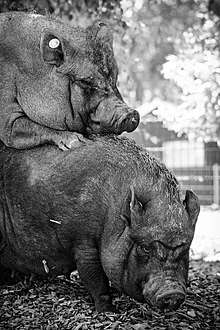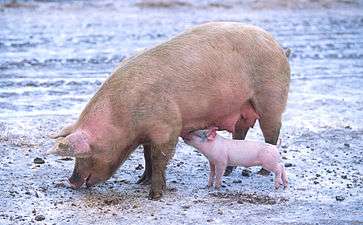Miniature pig
Miniature pig—known by other terms that erroneously, disproportionately describe size—is used to refer to small breeds of domestic pig, such as Vietnamese Pot-Bellied pigs, Göttingen minipigs, Juliana pigs, Choctaw hogs or Kunekunes (and specimens derived by crossbreeding with these breeds). Notable features of most miniature pigs distinguishing them from other pigs may be defined by their possession of small, perked-back ears, a pot belly, a swayed back, a chubby figure, a rounded head, a short snout, short legs, a short neck and a short tail with thick hair at the end.[1] Typically, most breeds of miniature pigs will range from the minimum weight of 50 pounds (23 kg) to 200 pounds (91 kg).
 Two female miniature pigs, one of which is attempting to mount the other | |
| Traits | |
|---|---|
|
History
In the 1960s, Chinese pigs that grew to be 68–91 kilograms (150–200 lb) were sent to zoos in Western cities[2] and were used for medical research in the fields of toxicology, pharmacology, pulmonology, cardiology, aging, and as a source of organs for organ transplantation.[3] These comparatively smaller pigs were easier to work with than larger pig breeds, which typically reach weights of 300–500 lb (140–230 kg).[4]
In the mid-1980s, Keith Connell of the Bowmanville Zoo in Ontario imported breeding Vietnamese Pot-Bellied pigs to Canada, which became the foundation for the pot-bellied pig in North America.[5] The breed is known for its small stature, swayed back, and pronounced pot belly. Because of custom laws, only their offspring could be sold in the United States. U.S. zoos were the main target for the piglets, but private owners soon began purchasing them as pets. Pet pot-bellied pigs started to appear everywhere; from New York apartment complexes to small suburban residences. Up to five additional imports were made in the following 10 years. To track the pedigrees, the Potbellied Pig Registry Service, Inc (PPRSI) was created to preserve these bloodlines and establish a breed registry in the United States. This registry was dissolved in the late 1990s.[5] Today, most pot-bellied pigs are little to never purebred, as the pure breed is critically endangered.
The Miniature Potbellied Pig Registry Service, Inc (MPPRSI) was established in 1993 to provide a registry for those pigs who were pedigreed in the PPRSI and met the breed standard, when fully grown not being more than[6] 60 centimetres (24 in) tall and weighing under 80 kilograms (180 lb).[7] All of the foundation pigs were dual registered in the PPRSI and MPPRSI.[5]
Beginning in the late 1960s at the Institute of Animal Breeding and Genetics (Institut für Tierzucht und Haustiergenetik) at the University of Göttingen, Germany, the Göttingen minipig was developed by crossbreeding the Minnesota minipig, the Vietnamese Pot-Bellied pig and the German Landrace pig. It is considered the smallest breed of domestic pig in the world.[8]
Medical research
Miniature pigs have been used for medical research, including toxicology, pharmacology, experimental surgery, pulmonology, cardiology, xenotransplantation, and aging studies. Pigs can be useful in studying human disease, and due to their high intelligence, are easy to manage in a laboratory setting.[6] For example, scientists are working on studying the possibility of utilizing pig hearts for human heart organ transplants, and work has been done to genetically modify the tissues of pigs to be accepted by the human immune system.[9]
As pets
_joven_en_las_calles_de_la_colonia_Condesa%2C_ciudad_de_M%C3%A9xico.jpg)
Miniature pigs are commonly kept as pets. Realistic sizes of pigs vary from pig to pig; genetics drives the growth, along with appropriate nutrition and care. Domesticated miniature pigs can vary from 25 kg (50 lbs) to 100 kg (200 lbs). It may be possible to reduce the risk of ending up with a large pig by looking at the pig's parents and grandparents if possible.[10] However, since pigs can breed years before they fully mature, unscrupulous or ignorant breeders may show off parent pigs which are not fully grown themselves, so have not reached their full adult size.[11]
Domesticated pigs are often trained to urinate and defecate in litter boxes. Typically, pine pellets or pine shreds are used. [12]
In the U.S., laws may vary on if a pet pig can be kept, depending on the location. If there are no laws regarding pet pigs, some areas may consider a pig to be exclusively known as livestock; some towns and cities have ordinances disallowing farm animals within city limits. However, one can petition city councils and have outdated ordinances amended before a pig is introduced into a household, since many ordinances were put into place before the pot-bellied pig was even introduced to the U.S.[13]
Other notable references
A Yucatan miniature pig is the unofficial mascot of the Animal Rescue League of Boston.[14]
The world's smallest wild pig species is the 71 centimetres (28 in) long wild pygmy hog which lives in Assam, India.[15] It is a critically endangered wild species, not appropriate for domestication.[16]
See also
References
- http://americanminipigassociation.com/educational/characteristics-differences-mini-pig-vs-full-sized-farm-breed/ Characteristics & Differences of a Mini Pig vs a Full-Sized Farm Breed
- John Pukite (1999). A field guide to pigs. ISBN 1-56044-877-6.
- Sachs, DH; Galli, C (2009). "Genetic Manipulation in Pigs". Current Opinion in Organ Transplantation. 14 (2): 148–153. doi:10.1097/mot.0b013e3283292549. PMC 2687522. PMID 19469029.
- "Ag Facts: Swine". Oklahoma4h.okstate.edu. 1985-03-05. Archived from the original on 2016-04-27. Retrieved 2016-04-04.
- "History". Miniature Potbellied Pig Registry Service, Inc. Retrieved 4 February 2013.
- "Tea Cup Pigs, Yay or Nay? | SiOWfa15: Science in Our World: Certainty and Controversy". sites.psu.edu. Retrieved 2017-03-08.
- "Breed Standard". Archived from the original on 2015-10-05. Retrieved 2014-07-22.
- Bollen, PJA & Ellegaard, L.(1996). Developments in Breeding Göttingen Minipigs. In Tumbleson & Schook (eds.) Advances in Swine in Biomedical Research. New York: Plenum Press
- Cooper, David K. C. (2017-03-08). "A brief history of cross-species organ transplantation". Proceedings (Baylor University. Medical Center). 25 (1): 49–57. doi:10.1080/08998280.2012.11928783. ISSN 0899-8280. PMC 3246856. PMID 22275786.
- Minimizing risk when buying a micro pig About Micro Pigs and their size - UK
- Teacup Pigs All the Rage, But Animal Welfare Group Urges People to do Homework Before Taking One Home October 28, 2009
- http://www.pigs4ever.com/resource.php?recordID=28
- "Changing city ordinance information- pig ordinance, pig regulations, pig approved homes, changing the law to allow pigs".
- Meet Rosie a Yucatan miniature pig May 10, 2009 NECN.com
- Mini pigs are big success on farm 15 October 2007 BBC News
- https://www.pennywellfarm.co.uk
